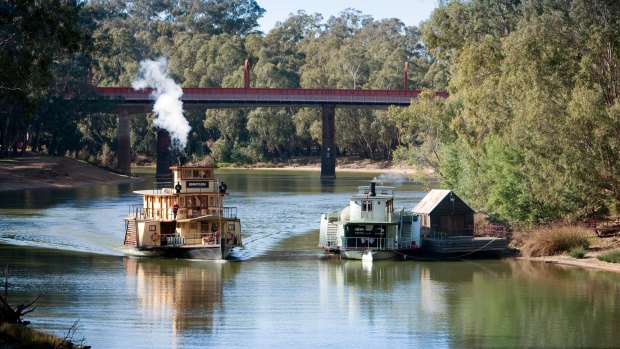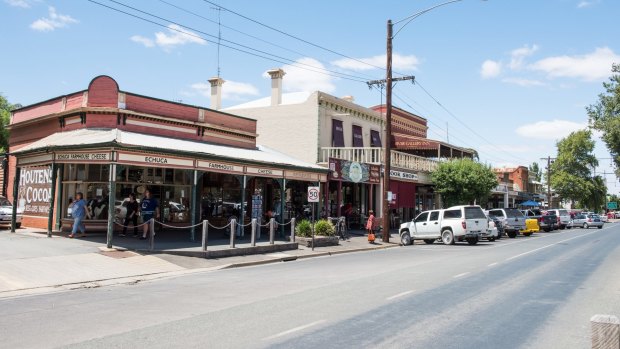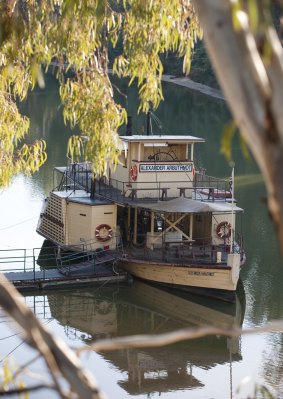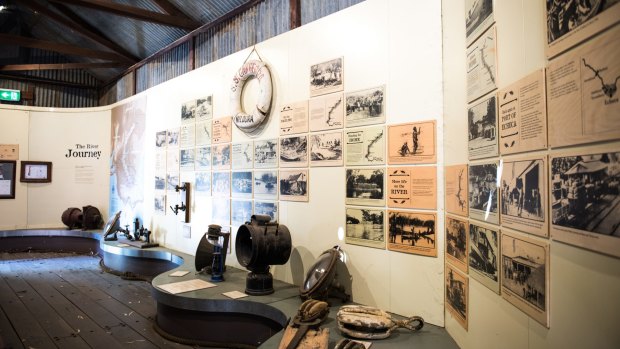This was published 3 years ago
Echuca, Victoria: How this tiny river town became Australia's largest inland port

A Murry Paddle steamer comes in to Echuca Wharf.Credit: Robert Blackburn
Chuntering along the Murray River on the PS Alexander Arbuthnot is an unquestionably idyllic way to spend an hour. Well, unless you're the poor engineer down below, continually throwing logs into the hungry boiler. The romance of being on board a paddlesteamer probably doesn't stretch to working on one.
The Alexander Arbuthnot is one of several paddlesteamers plying their trade from the Victorian river town of Echuca. It departs from Echuca Wharf, a colossal structure towering above the Murray and stretching 75.5 metres down its Victorian bank.
But the wharf isn't nearly as big as it was. In its 19th century heyday, it was 332 metres long. And, while you seemingly can't move for paddlesteamers, today's roster is a relative trifle.

Rivertown: Echuca was founded in 1854.Credit: Emily Godfrey
Echuca was founded in 1854, and very quickly became Australia's largest inland port. Part of this was due to being on a relatively narrow bend in the Murray River, which proved a logical crossing point between Victoria and NSW.
The key geographical bonus, though, was being the closest point on the Murray to Melbourne. Goods from across the Murray Darling basin could be brought to Echuca for unloading, then transported to Melbourne.
The story is told inside the Port of Echuca Discovery Centre on top of the wharf. Former convict Henry Hopwood is regarded as the town's founder, setting up a punt ferry to take goods across the river. He also opened Echuca's first inn, which in keeping with the dozens of others that sprang up to cater to thirsty port workers, was not especially salubrious.

Paddle steamer PS Alexander Arbuthnot on the Murray River at Echuca.Credit: Robert Blackburn
Hopwood arrived in 1849, which proved fortuitous as, four years later, it was demonstrated that the Murray was navigable. The colony of South Australia commissioned Francis Cadell to build the river's first paddlesteamer, and he chose to do it at Echuca because of the seemingly endless supply of timber.
The vast river red gum forests around Echuca played a big part in the river port's explosive growth. But it was wool, rather than wood, that was the true passport to riches. Sheep stations spread out for hundreds of kilometres along the Murray, Darling and Murrumbidgee Rivers. Given the prohibitive cost of land transport, floating the wool along the rivers to Echuca made these stations economically viable.
The river trade led to pastoralists heading further and further inland, and the wool kept coming through Echuca. By the 1870s, the town was receiving £2 million worth of wool per year. The equivalent today would be around $293 million.

Port of Echuca Discovery Centre.Credit: Emily Godfrey
The boom was partly fuelled by the rail link to Melbourne, which opened in 1864. But the dawn of the railways soon became a curse, rather than a blessing. In 1885, a rail line opened from Sydney to Bourke in NSW. For the pastoralists along the Darling River, it suddenly became cheaper to send the wool upriver to Bourke, and avoid the cross-border taxes incurred by delivering it to Victoria.
The timber industry was still viable – the Evans Saw Mill on top of Echuca Wharf where the Discovery Centre now stands kept going until 1983. The riverboat trade, however, gradually got replaced by rail, then road.
The last working paddlesteamer on the Murray was built in 1916 as a barge, then refitted as a paddlesteamer in 1923. Its name? The PS Alexander Arbuthnot.
This old warhorse, as with the rest of Echuca's paddlesteamer fleet, has been repaired, restored and put to work with an altogether different cargo. Wool and wood are gone, replaced by visitors making the most of the Mighty Murray.
TRIP NOTES
STAY
The Quest apartment hotel offers studio rooms for from $169. See questapartments.com.au
VISIT
Paddlesteamer cruises can be booked at the Port of Echuca Discovery Centre, and include entry to the museum-style exhibits in the centre. See portofechuca.org.au
MORE
David Whitley was a guest of Tourism Australia.
Sign up for the Traveller Deals newsletter
Get exclusive travel deals delivered straight to your inbox. Sign up now.